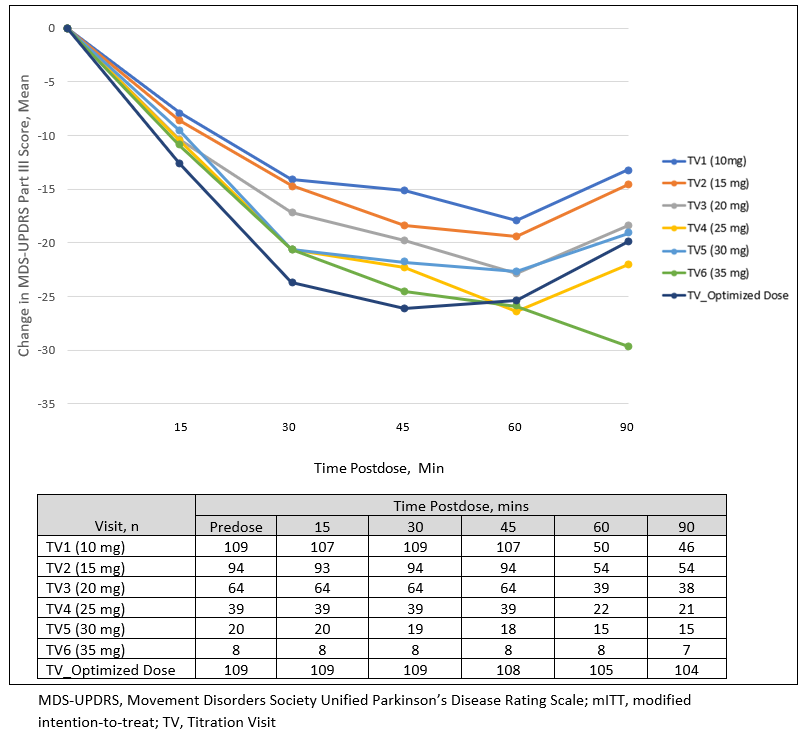Category: Parkinson’s Disease: Clinical Trials
Objective: Evaluate magnitude of motor improvement with increasing doses of apomorphine sublingual film (SL-APO) in patients with Parkinson’s disease (PD) and OFF episodes.
Background: Identifying an optimal dose of SL-APO is essential to ensure patients experience the maximal potential motor benefit from SL-APO. Titration of SL-APO can identify the optimal dose that provides an effective and tolerable motor response.
Method: The pivotal study (NCT02469090) of SL-APO enrolled patients with PD and OFF episodes on stable baseline medications. Patients underwent open-label titration of SL-APO (10–35 mg; 5-mg increments) during a practically defined OFF to identify the dose that resulted in a tolerable full ON by 45 min. At the Investigator’s discretion, the next highest dose could be evaluated to assess for an improved motor response at a higher dose, if tolerated. Improvement based on MDS-UPDRS Part III score at 15, 30, 45, 60, and 90 minutes postdose was evaluated for each dose during titration.
Results: This analysis included 109 patients who completed the titration phase and identified an optimal dose of SL-APO. Two-thirds were optimized on SL-APO doses between 15-25 mg (10 mg, 18%; 15 mg, 27%; 20 mg, 21%; 25 mg, 19%; 30 mg, 8%; 35 mg 6%). At optimized doses, the mean (SD) change from baseline to 30 minutes postdose in MDS-UPDRS Part III scores at the end of the titration phase was -23.7 (11.46). When evaluated by dose, a trend of incremental improvement in motor symptoms is observed with increasing doses up to a patient’s final optimized dose, based on change in MDS-UPDRS Part III score from predose to 15-90 minutes postdose [figure 1]. At suboptimal doses, SL-APO still provided clinically meaningful improvement in motor symptoms at all timepoints. Additionally, between 30-45 mins postdose, an average incremental decrease in MDS-UPDRS Part III score of -2.4 (range -1.0 to -3.9) was observed [table 1], which is lower than the MCID of -3.25 [1].
Conclusion: Incremental motor improvement is observed with increasing doses of SL-APO, suggesting that evaluation of higher doses during titration may allow for dose optimization. Minimal change in MDS-UPDRS Part III scores between 30-45 mins postdose indicates that if a full ON response is not achieved by 30 mins, the patient may require a higher dose. Dose optimization may offer greater clinical benefit and should be attempted as tolerated.
References: [1] Horváth K, Acshermann Z, Ács P, et al. Minimal clinically important difference on the Motor Examination part of MDS-UPDRS. Parkinsonism Relat Disord. 2015;21(12):1421-1426.
To cite this abstract in AMA style:
S. Isaacson, I. Zhang, E. Pappert, A. Bowling. Apomorphine Sublingual Film for OFF Episodes in Parkinson’s Disease: Incremental Motor Improvement Observed with Increasing Doses [abstract]. Mov Disord. 2022; 37 (suppl 2). https://www.mdsabstracts.org/abstract/apomorphine-sublingual-film-for-off-episodes-in-parkinsons-disease-incremental-motor-improvement-observed-with-increasing-doses/. Accessed January 5, 2026.« Back to 2022 International Congress
MDS Abstracts - https://www.mdsabstracts.org/abstract/apomorphine-sublingual-film-for-off-episodes-in-parkinsons-disease-incremental-motor-improvement-observed-with-increasing-doses/


